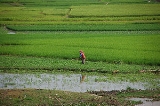
Takéo
Encyclopedia
- For the Japanese city, see Takeo, SagaTakeo, Sagais a city located in Saga Prefecture on the island of Kyūshū, Japan.-Geography:Takeo is located in the western part of Saga Prefecture. It is approximately west of Saga City and approximately east of Sasebo. Takeo has a complex topography including mountains, mountain basins and riverside...
.
Takéo is the capital of Takéo Province, Cambodia. As of 1998 it had a population of 39,186. The town and province is known for its silk weaving and the province is home to about 10,000 of the total of 15,000 Cambodian weavers. Most silk weavers in the villages are near the national highway in the direction of Takeo town. The technique of silk weaving could have possible come to the Khmer during the Funan Empire, probably in the 2nd Century, from India and China.
Sites
- Chisor Phnom - Phnom Chisor is a mountain north of the city of Takeo. At the summit you will find some temple ruins from the 10th and 11 Century. From the mountain you have a good outlook on the environment. The climb is 503 steps. At the summit there is a simple beverage stalls. For the 26-kilometer Journey can take a moped.
- Phnom Da - a 17 meter high temple dating back to the from the Funan kingdom (6th century) on a 100 m high hill. It can be reached by an hour boat ride from Takeo. Farmers on the partially flooded rice fields and fishermen and many duck farms can be observed. Large wooden boats deliver cargoes from Vietnam.
- Angkor Borei - On the road from the town of Takeo is Phnom Da temple. Previously, this was an important trading center. At the harbor there is a small museum documenting the Funan kingdom.
Notable people
- Chinary UngChinary UngChinary Ung is a composer now living in the United States. After arriving in the United States in 1964 to study the clarinet, Ung studied composition with Chou Wen-chung and Mario Davidovsky. Ung is noted for combining traditional Cambodian musical elements with western instrumentation...
(1942-) -composer

